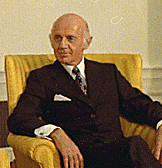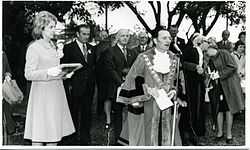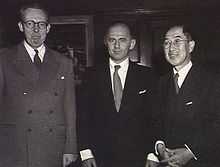William McMahon
| The Right Honourable Sir William McMahon GCMG, CH | |
|---|---|
 | |
| McMahon in November 1971 | |
| 20th Prime Minister of Australia Elections: 1972 | |
| In office 10 March 1971 – 5 December 1972 | |
| Monarch | Elizabeth II |
| Governor General | Sir Paul Hasluck |
| Deputy | Doug Anthony |
| Preceded by | John Gorton |
| Succeeded by | Gough Whitlam |
| 4th Leader of the Liberal Party of Australia | |
| In office 22 March 1971 – 20 December 1972 | |
| Deputy | John Gorton Billy Snedden |
| Preceded by | John Gorton |
| Succeeded by | Billy Snedden |
| Minister for Foreign Affairs | |
| In office 12 November 1969 – 22 March 1971 | |
| Prime Minister | John Gorton William McMahon |
| Preceded by | Gordon Freeth |
| Succeeded by | Leslie Bury |
| Treasurer of Australia | |
| In office 26 November 1966 – 25 October 1969 | |
| Prime Minister | Harold Holt John McEwen John Gorton |
| Preceded by | Harold Holt |
| Succeeded by | Les Bury |
| Minister for the Navy | |
| In office 17 July 1951 – 9 July 1954 | |
| Prime Minister | Robert Menzies |
| Preceded by | Philip McBride |
| Succeeded by | Josiah Francis |
| Minister for Air | |
| In office 17 July 1951 – 9 July 1954 | |
| Prime Minister | Robert Menzies |
| Preceded by | Philip McBride |
| Succeeded by | Athol Townley |
| Member of the Australian Parliament for Lowe | |
| In office 10 December 1949 – 13 March 1982 | |
| Preceded by | New seat |
| Succeeded by | Michael Maher |
| Personal details | |
| Born | 23 February 1908 Sydney, Australia |
| Died | 31 March 1988 (aged 80) Sydney, Australia |
| Political party | Liberal Party of Australia |
| Spouse(s) | Sonia McMahon (m. 1965–1988) |
| Children | Melinda Julian Deborah |
| Alma mater | University of Sydney |
Sir William "Billy" McMahon, GCMG, CH (23 February 1908 – 31 March 1988), was an Australian Liberal politician and the 20th Prime Minister of Australia. He was the longest continuously serving government minister in Australian history (21 years and 6 months) and held the longest tenure as Prime Minister without leading his party to victory at an election.
Early life
William McMahon was born in Sydney, the son of Mary Ellen Amelia (née Walder) and William McMahon, a lawyer.[1] His uncle (his mother's brother) was Samuel Robert Walder, Lord Mayor of Sydney.[2] His father was of Irish descent. McMahon's mother died when he was 9 and his father when he was 18.[3] He was educated at Sydney Grammar School and at the University of Sydney, where he graduated in law. He practised in Sydney with Allen, Allen & Hemsley (now Allens Arthur Robinson), the oldest law firm in Australia. In 1940 he joined the Army, but because of a hearing loss, he was confined to staff work. After World War II, he travelled in Europe and completed an economics degree at the University of Sydney.[4]
Politics

William McMahon was elected to the House of Representatives for the Sydney seat of Lowe in 1949, one of the flood of new Liberal MPs known as the "forty-niners". He was capable and ambitious, and in 1951 Prime Minister Robert Menzies made him Minister for Air and Minister for the Navy. McMahon would serve in Cabinet in one capacity or another for the next 21 years.
At various times under Menzies, he served as Social Services, Primary Industry and Labour and National Service, and he was also Vice-President of the Executive Council. In 1966, when Harold Holt became Prime Minister, McMahon succeeded him as Treasurer and as Deputy Leader of the Liberal Party.
Despite his steady advance, McMahon remained unpopular with his colleagues. He was highly capable, but seen as too ambitious and a schemer. He had never married, and there were frequent rumours throughout his life that he was homosexual.[5] In 1965, aged 57, he married Sonia Rachel Hopkins, who was then aged 32. They had three children: Melinda, Julian (who would find fame in his own right as a model and an actor), and Deborah.
When Holt drowned in December 1967, McMahon was assumed to be his probable successor. However, John McEwen, interim Prime Minister and leader of the Country Party, announced that he and his party would not serve in a government led by McMahon. McEwen did not state his reasons publicly, but privately he told McMahon he did not trust him. McEwen, an arch-protectionist, correctly suspected that McMahon favoured policies of free trade and deregulation.

McMahon therefore withdrew, and Senator John Gorton won the party room ballot for party leader and Prime Minister. McMahon became Foreign Minister and waited for his chance at a comeback. The Coalition was nearly defeated at the 1969 election. After the election, McMahon challenged Gorton for the leadership, but failed in part because of McEwen's continued opposition.
In January 1971, McEwen retired as Country Party leader and Deputy Prime Minister. His successor, Doug Anthony, discontinued the veto against McMahon. In March 1971 the Defence Minister, Malcolm Fraser, resigned from Cabinet and denounced Gorton, who then announced a leadership spill. The party room vote on a motion of no confidence was initially tied, which meant the motion was lost. Nevertheless, Gorton voluntarily declared that a tie vote meant he no longer had the confidence of the party, and relinquished the leadership. McMahon was then elected leader (and Prime Minister), and Gorton was elected deputy Liberal leader.
Prime Minister

McMahon came into office at a bad time for the Coalition, which was increasingly seen as tired and unfocused after 22 years in power. His first problem was Gorton. McMahon was all but forced to name him Defence Minister. This farcical situation came to a head when Gorton published two articles detailing the problems he'd had with ministers leaking information from cabinet. McMahon forced Gorton's resignation.[6] Billy Snedden was chosen as the new deputy Liberal leader.
McMahon found himself dealing with a resurgent Labor Party under Gough Whitlam. Labor had come within four seats of winning government in 1969, and since then had positioned itself as a credible government-in-waiting. Over the next year-and-a-half, McMahon was unable to get the better of Whitlam. McMahon was no match in parliamentary debates for Whitlam, a witty and powerful orator. He frequently found himself on the defensive as Whitlam attacked the increasingly unpopular Vietnam war and advocated radical new policies such as universal health insurance. In a typical instance, McMahon attacked Whitlam for his demands that Australia recognise the People's Republic of China, only to have to back down when President Nixon announced his visit to China. He is not helped by rising inflation, which hurt his reputation as a sound economic manager. It did not help matters that the Liberal Party was showing severe ructions, which came at an especially bad time since McMahon faced a statutory general election in 1972.[6] His voice and appearance also came across rather badly on television.
In June 1971 McMahon cancelled Gorton's planned nuclear power program, which had included a reactor capable of generating weapons-grade plutonium. He considered it inconsistent with the goals of the Nuclear Non-Proliferation Treaty, signed under Gorton in 1970, and later ratified under Whitlam in 1973.[7]
McMahon went into 1972 facing a statutory general election. By then, Labor had established a clear lead in the polls, and McMahon's approval ratings had dwindled to 28 percent. The press had turned on him so violently that British psephologist David Butler recalled on a visit to Australia that he could not recall a prime minister in any country being "so comprehensively panned" as McMahon. By then, it was widely perceived that McMahon simply "did not look or sound like a Prime Minister." He waited for as long as he could, but finally called an election for 2 December. During the campaign, McMahon was abandoned by some of his own ministers, unheard of in a Westminster system.[8] The Coalition was swept from power on an eight-seat swing. Late on election night, with the result beyond doubt, McMahon conceded defeat, ending the longest unbroken run in government in Australian history.
McMahon had been a minister continuously for 21 years and 6 months, a record in the Australian Government that has never been threatened. Only Sir George Pearce and Sir John McEwen had longer overall ministerial service, but their terms were not continuous.
Later life
McMahon served in the Shadow Cabinet under his successor Billy Snedden, but was dropped after the 1974 election. He retained his seat in Parliament in the 1975, 1977 and 1980 elections. He became Joint Father of the House of Representatives with Clyde Cameron in 1977, and sole Father in 1980 when Cameron retired. On the retirement of Senator Justin O'Byrne in 1981, he became Father of the Parliament. He resigned from Parliament in 1982.
McMahon died of cancer in Sydney on 31 March 1988 at 80.[9] His widow Lady (Sonia) McMahon died aged 77 on 2 April 2010,[10] 22 years after his death.
Honours

McMahon was appointed a Privy Counsellor in 1966, a Companion of Honour in the New Year's Day Honours of 1972[11] and a Knight Grand Cross of the Order of St Michael and St George in the Queen's Birthday Honours of 1977.[12]
Following the 2009 redistribution of New South Wales federal electorates, the Division of Prospect was renamed the Division of McMahon starting at the 2010 federal election.[13]
See also
References
- ↑ http://adb.anu.edu.au/biography/mcmahon-sir-william-billy-15043
- ↑ Twelfth man? – Don Whitington – Google Books. Books.google.ca. Retrieved 15 August 2012.
- ↑ "Before office – William McMahon – Australia's PMs – Australia's Prime Ministers". Primeministers.naa.gov.au. Retrieved 15 August 2012.
- ↑ 'John Hawkins'. "'William McMahon: the first Treasurer with an economics degree'". Retrieved 5 October 2012.
- ↑ e.g. "As a bachelor navy minister he was notorious for co-opting handsome young sailors in tight-fitting bell-bottom trousers to caddy for him at golf". Charlton, Peter. Australia's Prime Ministers in Birth Of Our Nation Special Supplement, The Courier-Mail, January 1, 2001; "former senior public servants recall McMahon when PM in the early 1970s would rove the men's dressing rooms at the old squash courts in Manuka. Wearing not a stitch, he was in the habit of approaching other men and virtually demanding they engage in long, often meaningless conversations.... The only newspaper report was a picture of McMahon with a black eye, which he said occurred in a game when he was hit by an opponent's racquet." Wright, Tony. The Dishonorable Member in The Bulletin July 9, 2005. See also: Mitchell, Susan Stand By Your Man: Sonia, Tamie & Janette, Random House 2007, ISBN 9781741665680 and Lady McMahon's response to Mitchell in The truth about my marriage, The Australian Women's Weekly, November 2007. Vol. 77 Issue 11, p50. The Everlasting Secret Family by Frank Moorhouse is a novel allegedly loosely based on McMahon's backstory.
- ↑ 6.0 6.1 Hancock, Ian. Events and issues that made the news in 1971. National Archives of Australia. Retrieved 2014-11-02.
- ↑ Christian Kerr. "Nation given N-bomb warning". Retrieved 8 November 2012.
- ↑ Hancock, Ian. Events and issues that made the news in 1972. National Archives of Australia. Retrieved 2014-11-02.
- ↑ Hawkins, John (2012). "William McMahon". Treasury. Retrieved 10 September 2013.
- ↑ Hornery, Andrew; Browne, Rachel; Whyte, Sarah (4 April 2010). "Sonia McMahon dies aged 77". Sydney Morning Herald. Retrieved 25 April 2010.
- ↑ "It's an Honour – CH". Itsanhonour.gov.au. 1 January 1972. Retrieved 25 April 2010.
- ↑ "It's an Honour – GCMG". Itsanhonour.gov.au. 12 June 1977. Retrieved 25 April 2010.
- ↑ "Augmented Electoral Commission decides boundaries and names for Federal Electoral Divisions in NSW". Aec.gov.au. 23 October 2009. Retrieved 25 April 2010.
Further reading
- Hughes, Colin A (1976), Mr Prime Minister. Australian Prime Ministers 1901–1972, Oxford University Press, Melbourne, Victoria, Ch.22. ISBN 0-19-550471-2
- Reid, Alan (1971), The Gorton Experiment, Shakespeare Head Press, Sydney.
- Sekuless, Peter (2000), 'Sir William McMahon,' in Michelle Grattan (ed.), Australian Prime Ministers, New Holland, Sydney, New South Wales, pages 312–323. ISBN 1-86436-756-3
External links
| Wikimedia Commons has media related to William McMahon. |
- "William McMahon". Australia's Prime Ministers. National Archives of Australia. Retrieved 29 June 2010.
- "William McMahon". National Museum of Australia. Retrieved 29 June 2010.
- William Mcmahon at the National Film and Sound Archive
| ||||||||||||||||||||||||||||||
|